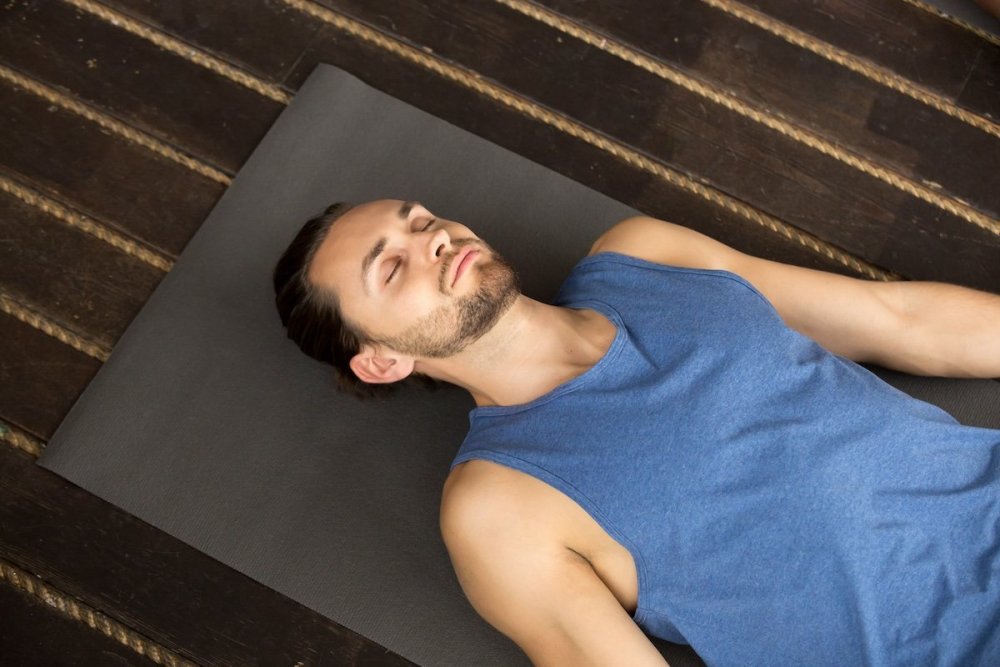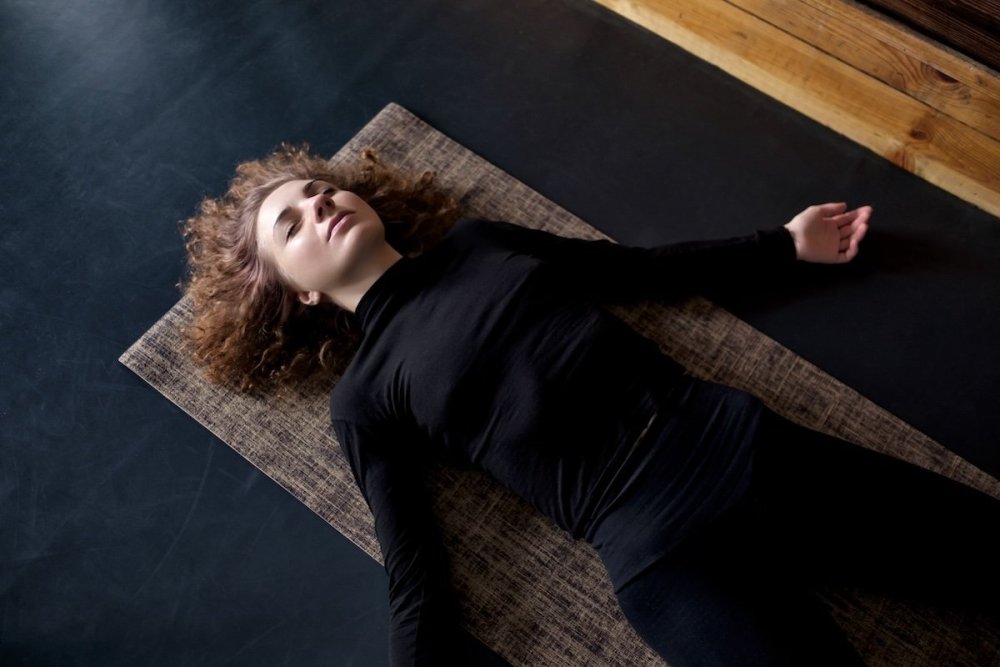Are you living with insomnia or poor slumber? Practising restful yoga nidra encourages deep relaxation, ideal for promoting a healthy night's rest. Ann Vrlak shows you how to do yoga nidra for sleep with her 4-step yoga nidra scipt and meditation guide.
If you're looking for a deeply restful meditation practice, read on to learn how to do yoga nidra. You can opt to meditate lying down or in bed, but yoga nidra is unique among meditation practices. Why?
Well, in case you've never heard of it before, yoga nidra is an ancient meditation practice first found in written form around 700BC. Its aim is to guide you into a slow, delta wave state where two things happen: you profoundly relax and rejuvenate your nervous system, and you create a receptive state of mind ready to absorb an important intention.
Is yoga nidra like other meditation?
Many traditional meditation practices focus on being aware of thoughts and feelings – a kind of gentle alertness. Yoga nidra, as a general practice, or yoga nidra for sleep, are designed to take you from conscious states of mind, through relaxed states, to a deep, unconscious but still-awake state.

Practise yoga nidra to profoundly relaxes your nervous system
Yes, that does sound contradictory, but that is what makes yoga nidra a distinct practice. It came out of a meditation tradition that believes the most experienced sages were conscious, even in deep sleep. Today, the interpretation is less esoteric: that yoga nidra puts the body in a physiological state similar to restful sleep, but the person is awake. It immerses the body and mind in a profound state of relaxation.
“Yoga nidra for sleep is designed to take you from conscious states of mind, through relaxed states, to a deep, unconscious but still-awake state.”
This is another key difference from most other meditations which encourage staying awake: the goal is deep relaxation that may lead directly into sleep. The meditation is done lying down, guiding you through progressively more relaxed states. For these reasons, yoga nidra for insomnia is a common form of the practice.
The benefits of yoga nidra
The healing and rejuvenation side of your nervous system, the parasympathetic, is strongly activated by yoga nidra. A whole host of physiological processes are set in motion that improve how your body functions, from your immune system, to reducing stress hormones, to releasing melatonin – the natural chemical that helps with sleep and anxiety.

Our yoga nidra script promotes deep relaxation, ideal for sleep
We mentioned that yoga nidra for sleep and yoga nidra for insomnia are practises that can help the many thousands of people worldwide who do not have regular, restful sleep – one of the key components of health and well-being.
How to do yoga nidra: 4 steps
In a typical yoga nidra session, there are four phases:
- Setting an intention
- Moving through a body scan
- Breathing mindfully and accepting experience
- Ending with a visualization
You can use the following yoga nidra script any time. It takes you step by step through how to do yoga nidra. However, practising yoga nidra for sleep, anxiety and insomnia are especially helpful if you have trouble getting off to slumber each night.
“The meditation is done lying down, guiding you through progressively more relaxed states. Yoga nidra for insomnia is a common form of the practice.”
This meditation practice can take anywhere up to one hour. To do a shorter practice, leave about 30 seconds between each line of the yoda nidra script. If you enjoy the practice, make the pauses as long as you like, to connect with and rest in the instructions.
Yoga Nidra Script
- Turn off any electronic devices and make sure you will not be interrupted.
- Physical comfort is essential for yoga nidra. You will be lying down for the full practice, so gather blankets, pillows, bolsters and eye covers to set up your body for a supported, comfortable practice. Take as long as you need.
- When you are ready to begin, start to notice the full plane of contact between your body and the floor or surface beneath you – from the back of your head to your heels.
1. Intention
- Set an intention for this practice that is important for your personal growth and happiness. Choose something that you feel would have wide-ranging, positive effects on your life. Feel the importance and the effect of your intention.
2. Body Scan
- Begin a body scan practice, beginning with your thumbs. Become aware of any sensations of warmth, tightness, energy in your thumbs. As you do, consciously relax the area.
- Move your attention steadily, and fairly quickly, through the rest of your body. Your hands, your arms, your head, your torso, hips, legs and feet. Sense each part as much as you can, holding your intention to rest each part you are aware of. You are not only sensing, but consciously relaxing.
3. Breathing
- Become aware of your whole body, resting, heavy and supported.
- Shift your attention to the sensations of your breath. Feel the rising and falling of your chest as the air enters and leaves your body. Notice the breath broadening and collapsing your body to the sides, and to the front and back.
- Feel the slight echoes of your breath rippling out through your whole body.
- If thoughts and emotions are present, also let them rest in this relaxed, open body. Let them be, supported and held in this mindful space.
- On your inbreath, feel energy filling every cell. On the outbreath, feel the letting go, the rest. The flow of life from activity to relaxation.
4. Visualization
- See in your mind’s eye the vast expanse of space. Stars and planets sit amidst a dark, warm blanket of space. Wherever you look, there are objects with unimaginable space between them, out into infinity.
- Imagine your thoughts and feelings are like the stars and planets, and you are the observing, embracing space. This observing part of you is present, like space, always there between and behind your experiences. Feel that spaciousness within you, a freedom to allow everything within.
- To finish your practise of yoga nidra, remember your intention. Hold it in your mind and body. Let this positive intention for yourself permeate your being.
- Rest for another few moments, feeling the effects of this practice of yoga nidra in your mind and body.
- Bring some gentle movements back to your body and slowly open your eyes or continue resting if your aim is to sleep.

How to do yoga nidra in four easy steps
Takeaway: yoga nidra
How did it go? You now know how to do yoga nidra for sleep and insomnia. You can also enjoy this unique practice any time you want to give your body and mind a deeply refreshing break.
The restful, receptive state that yoga nidra generates is different from other forms of meditation or relaxation. Especially if you do the practice for longer periods of time, you can immerse yourself in a peaceful, rejuvenating space that is unparalleled. You create for yourself a safe space for all parts of your experience, to be held with warmth and acceptance. •
Images: shutterstock/Koldunov, shutterstock/fizkes, shutterstock/wavebreakmedia
happiness.com | The fine art of being: learn, practise, share
Are you a happiness.com member? Sign up for free now to:
■ enjoy our happiness magazine with practical life tips
■ share and support others in our happiness forum
Hatha yoga | Stress management | Burnout
Written by Ann Vrlak
 Ann Vrlak is Founder of OneSelf Meditation and a meditation practitioner for over 25 years. She’s a Certified Meditation Teacher for adults and for children (the best job ever!). She loves to share how the perspective and practice of meditation can support people with their everyday stresses and on their journey of self-discovery.
Ann Vrlak is Founder of OneSelf Meditation and a meditation practitioner for over 25 years. She’s a Certified Meditation Teacher for adults and for children (the best job ever!). She loves to share how the perspective and practice of meditation can support people with their everyday stresses and on their journey of self-discovery.
Join the conversation
You are posting as a guest. If you have an account, sign in now to post with your account.
There are no comments to display.